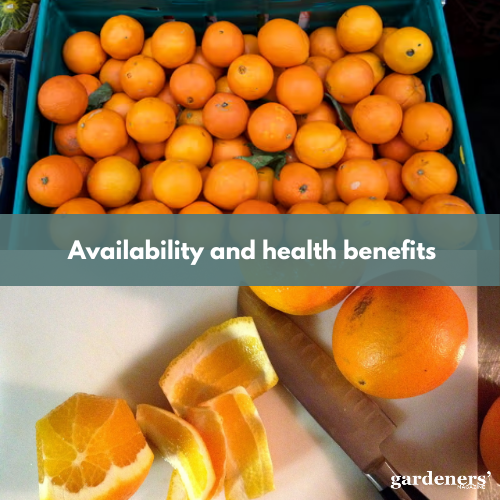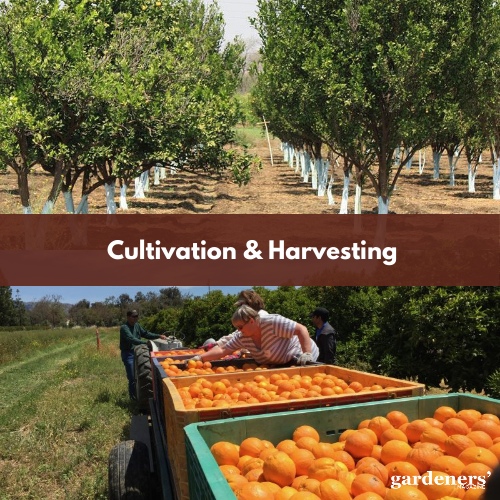If you’re someone who like mangoes and oranges, then you’re going to love this one!
Mango oranges are a unique variety of citrus fruit closely related to mandarins. They have a sweet-tart flavor and are often used in recipes for pies, jams, sauces, and other desserts. The flesh of the mango orange is juicy, and the peel has a reddish-orange hue. They are smaller than regular oranges and have a unique shape with slightly flattened sides.
If Mango Oranges have piqued your interest, then join me as we uncover everything about this unique produce.

What is Mango 0range?
Mango orange is a hybrid fruit created by crossing a mandarin orange and a mango. It has the distinctive flavor of both fruits, combining the sweet and tart notes of an orange with the tropical sweetness of a mango. The texture is smooth, juicy, and pulpier than its parent fruits. Mango oranges can be eaten as-is or used in juices, smoothies, and dessert recipes.
Despite their popularity, mango oranges are not widely available in grocery stores. However, they are often found in specialty fruit shops or online retailers.
These are seasonally available in online grocery stores such as Instacart and Central market, along with supermarkets such as Wholefoods and WincoFoods. You can also get your hands on them through online Private distributors.

History and Origin of Mango Oranges:
Mango oranges are most likely to be native to Italy. While there isn’t much information about its history and origins, some records indicate that Genoese sailors introduced original cultivars of the sweet vanilla-scented oranges to Sicily sometime in the 15th century.
The sailors supposedly sourced the oranges from China or the East Indies, and once introduced in Sicily, the oranges were selectively bred over time, naturally mutating and creating new variations, including seedless fruits. Mango oranges eventually became popular and spread throughout Europe as a specialty citrus and were introduced to the United States, specifically California, where a few growers cultivate the variety.

Description of Mango Oranges:
Mango oranges are an exotic citrus fruit that grows mainly in tropical and subtropical regions. They have bright orange skin, firm flesh, and a sweet-tart flavor. The average size of mango oranges is around 6 cm in diameter, although some can be much larger. The inner flesh of mango oranges is a vibrant yellow-orange color with a juicy, pulpy consistency. The flavor of these oranges is sweet, with a hint of tartness that lingers on the tongue. An interesting feature of this variety is that each orange is filled with shades of different colors such as orange, orange-pink, and pink-red, and just like a fingerprint, no orange will have the same appearance.
Due to its high juice content, it sometimes feels like its melting in my mouth. Mango oranges release a sweet and floral aroma with subtle nuances of vanilla. The variety contains little to no acidity, contributing a mild, sweet, and somewhat one-dimensional taste combined with notes of vanilla to create a flavor reminiscent of a creamsicle.
Flavor Profile of Mango Oranges:
This fruit will give your taste buds an experience like no other!
What you will savor is a sweet and tangy flavor with hints of citrus. The juicy flesh has mango, orange, and tangerine notes, with a slight tartness that finishes off the flavor. The sweetness is perfectly balanced by the tangy flavor of citrus fruits, making it an incredibly refreshing treat. The aroma is a sweet mix of mango and orange, with just a hint of tartness.
Due to its high juice content, it sometimes feels like its melting in my mouth. Mango oranges release a sweet and floral aroma with subtle nuances of vanilla. The variety contains little to no acidity, contributing a mild, sweet, and somewhat one-dimensional taste combined with notes of vanilla to create a flavor reminiscent of a creamsicle.

Seasonality and Availability Throughout the Year of Mango Oranges:
Mango Oranges are generally available from late spring to mid-summer. They tend to be firmer and more tart when they first come into season, but as the summer progresses, the flavor becomes sweeter.
The peak of their season is usually in June or July when Mango Oranges are most abundant and have the best flavor. Once the harvest winds down in late summer, Mango Oranges become much less common and more expensive. Some areas may still be available into October or even November.
Health Benefits of Mango Oranges:
Being the hybrid of the mandarin orange and the mango, this fruit packs all the goodness which you would expect from it. This unique fruit provides a wide range of health benefits due to its high vitamins, minerals, antioxidants, and fiber content.
One major benefit of consuming mango oranges is that they are rich in vitamin C. This important antioxidant helps to improve immune function and protect against cell damage and reduce inflammation in the body.
Mango oranges are also high in dietary fiber that helps to promote digestive health and keeps you feeling full for longer.

Cultivation of the Mango Oranges:
Mango Oranges can be grown from seed. However, they are best propagated by cuttings. The cutting should have at least two to three leaves and 10 cm of stem. To propagate the cutting:
- Choose an area that receives good natural light and is well-drained.
- Dig a hole about twice the size of the root ball, mix in compost or well-rotted manure, and fill it with adequate soil.
- Place the cutting in the hole and fill it with soil.
- Water the soil well and keep it damp until roots form.
- Once roots form, water regularly to prevent the soil from drying out.
Fertilize them every two weeks with a balanced fertilizer to encourage healthy growth. Mango Oranges should be pruned in the spring and summer months to help encourage new growth. Be sure to remove dead, diseased, or damaged branches and any sucker stems that may appear. With regular pruning and care, Mango Oranges can bear fruit within two to three years.
Harvesting of the Mango Oranges:
Mango oranges are typically harvested by hand due to their thin skins and delicate nature. The harvest season for mango oranges generally begins in May and ends in August. The best time to harvest the fruit is when it has reached its peak ripeness, which can be determined by its bright orange color and soft texture.
Once the mango oranges are harvested, they must be handled with extra care to avoid bruising or damage. The best way to do this is to carry the fruit in boxes or other containers with soft cloth or foam.
After harvesting, the mango oranges should be washed with clean, cold water to remove dirt or debris. They can then be consumed fresh or stored in a cool, dry place for later use. If stored properly, the mango oranges can last up to four weeks before they need to be consumed or thrown away.
Where Do Mango Oranges Grow?
Today Mango oranges are a rare citrus grown on a small scale, mainly in Europe and the United States. Usually, the variety is sold through local markets in its growing region and is shipped in small quantities to distributors and select retailers for sale as a fresh market item.
In US, these oranges are mainly grown in Organic farms in the in California. Mango oranges are also grown in Florida (which is the largest citrus producing state in U.S)
What are the things to remember when buying Mango Oranges?
- Check the color and texture of the mango oranges. Choose ones with a bright orange hue, firm but not too hard, and free from bruises or spots.
- Make sure that the stem is still attached to the product. This indicates freshness as well as harvesting by hand.
- Smell the mango oranges before buying them. The smell should be strong and pleasant since it has a sweet, fragrant aroma.
- Avoid buying overly soft or mushy to the touch, as this indicates they may not be fresh anymore.
- Before purchasing large quantities of mango oranges, buy a smaller quantity first to ensure that it meets your expectations in terms of taste and quality.
These tips should help ensure you get quality mango oranges for your next grocery shopping.
What is the best way to Store Mango Oranges?
The best way to store Mango Oranges is to keep them in a cool, dry place. Ensure that the storage area’s temperature remains between 55-65 degrees Fahrenheit. Avoid storing mango oranges near heat sources such as stoves and radiators or in direct sunlight. Ensuring your storage area’s environment is warm enough is also important. The optimal humidity for storing mango oranges is between 55-65%.
If you cannot store the mango oranges in a cool, dry place, it is still possible to keep them fresh. Store the mango oranges in an airtight container or plastic bag in the refrigerator. Make sure they are completely covered so that no moisture seeps. When stored this way, the mango oranges should be good for up to four weeks.

Various Culinary Uses:
Mango oranges work wonderfully in recipes with various other fruits and vegetables. For example, you can make delicious salsa with tomatoes, peppers, onions, and cilantro. They also pair well with tropical fruits like pineapple, kiwi, and papaya for an exotic fruit salad. Additionally, mango oranges are amazing in smoothies or blended with other fruits and vegetables to create a nutritious juice.
You can use these sweet citruses as a topping for oatmeal or yogurt, added to muffins, or incorporated into Asian-inspired stir-fries. The possibilities are endless! Experiment with different combinations and see what works best for you.
Conclusion
Mango Oranges are an incredibly versatile fruit that can be used in various recipes; however, its rarity and lack of mass production makes it a difficult fruit to get your hands upon. It certainly stands apart from the rest of the orange family in terms of taste and experience.
So, whenever you come across them while grocery shopping, make sure to put them in the basket.
FAQ’s
Q.1- What are Mango Oranges?
Ans.- Mango orange is a hybrid fruit created by crossing a mandarin orange and a mango. It has the distinctive flavor of both fruits, combining the sweet and tart notes of an orange with the tropical sweetness of a mango.
Q.1- Where are Mango Oranges available?
Ans.- These are seasonally available in online grocery stores such as Instacart and Central market, along with supermarkets such as Wholefoods and WincoFoods. You can also get your hands on them through online Private distributors.
- Everything You Wanted to Know About Red Tamarillos - June 2, 2025
- A Guide to Tulips: Everything You Need to Know & More… - June 2, 2025
- Guanabana: Description, Flavor, Benefits, And Uses - May 27, 2025

8 thoughts on “Mango Oranges: Description, Flavor, Benefits, Uses & More…”
Comments are closed.